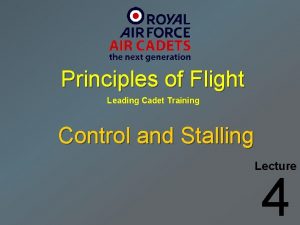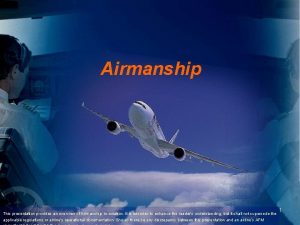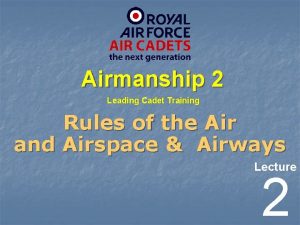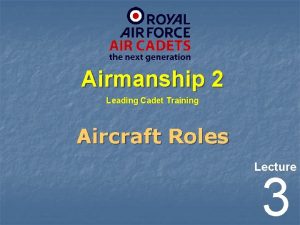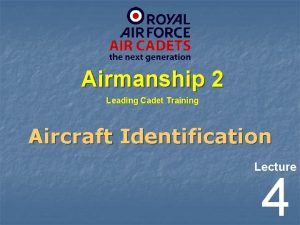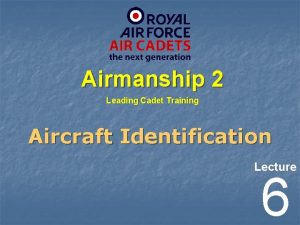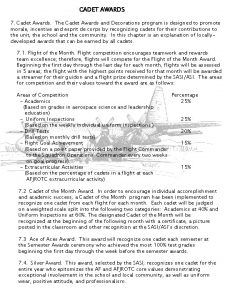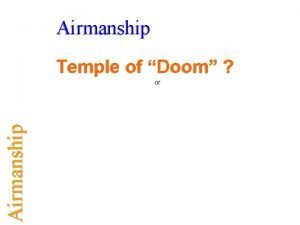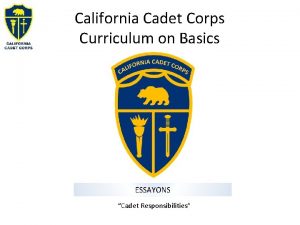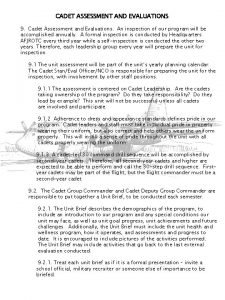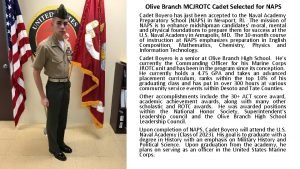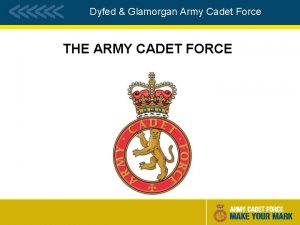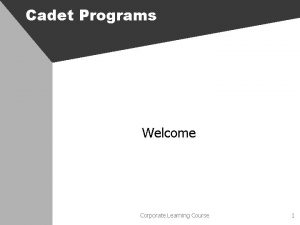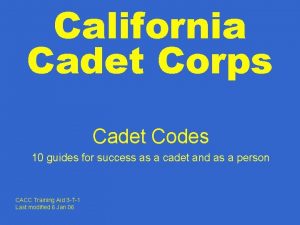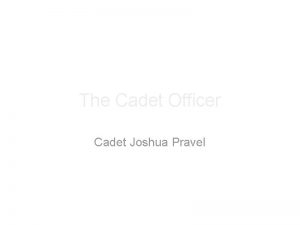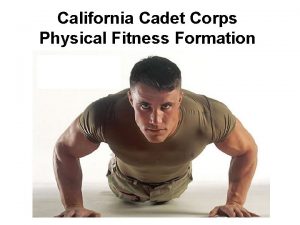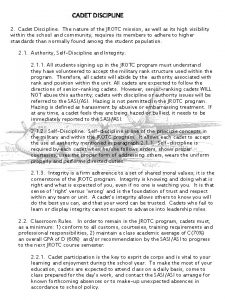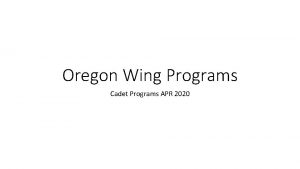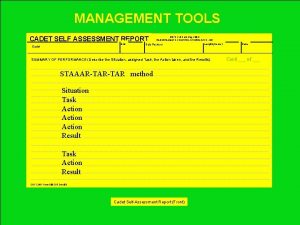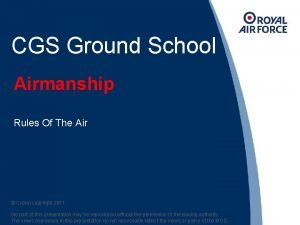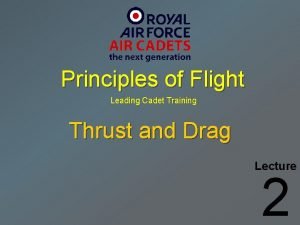Airmanship 2 Leading Cadet Training Rules of the

































- Slides: 33

Airmanship 2 Leading Cadet Training Rules of the Air and Airspace & Airways Lecture 2

Introduction Without the Highway Code cars on the road would find it impossible to move about safely. There also rules to govern how aircraft move about the sky, to avoid accidents. They are called “Right of Way” rules.

Rights of Way Everything gives way to balloons. BALLOONS Gliders have right of way over airships & powered aircraft. GLIDERS There are FOUR types or aircraft. Airships have right of way over powered aircraft. AIRSHIPS Powered aircraft give way to everything. POWERED AIRCRAFT

Rights of Way When approaching head on, each aircraft must alter course to the Starboard (Right).

Rights of Way When on converging courses at the same height, the aircraft with the other on its Starboard (Right) must give way.

Rights of Way When overtaking, the aircraft being overtaken has the ‘right of way’. The one overtaking must turn to the Starboard (Right).

Rights of Way Landing An aircraft landing, or on final approach to land, has right of way over aircraft in flight or on the ground.

Rights of Way Landing When two or more aircraft are approaching to land, the lower one has right of way.

Rights of Way On the Ground Aircraft and vehicles being taxied give way to aircraft being towed. Vehicles not towing give way to aircraft being taxied.

Rules at Night Aircraft have different styles of Navigation Lights. A balloon has one RED light suspended 5 to 10 m below the basket. An airship in flight, has WHITE lights fore & aft, GREEN on top & and RED below. A stationary airship, has WHITE lights fore & aft, with two RED lights below.

Rules at Night Aircraft have different styles of Navigation Lights. A glider has a central RED light Conventional powered aircraft have a WHITE light at the rear, a RED light to port and a GREEN light to starboard

Rules at Night Converging If pilot (A) looks out to starboard and sees a RED light moving alongside (B), He knows that the other aircraft has right of way and he must take action to avoid a collision. But pilot (B) should be ready to take avoiding action in case pilot (A) has not seen him B A

Avoiding Other Aircraft Directly ahead of the aircraft is 12 o’clock Directly astern is 6 o’clock Indicate HIGH, LEVEL or LOW Relative to YOUR aircraft Alert pilot to position using Clock Code system

Avoiding Other Aircraft For Example – 2 o’clock Low 8 o’clock High

Airspace Used to safely control and manage Air Traffic, airspace is divided into two main classes: Controlled Airspace and Uncontrolled Airspace “Controlled Airspace” has strict rules on the conduct of flying within them.

Airways Ensure safe passage of aircraft in congested airspace. Any aircraft can use them providing: A. The pilot has a valid instrument rating. B. The aircraft is fitted with appropriate radio and navigational equipment. C. The flight is made in accordance with the rules.

Airways Are between 10 and 20 nautical miles wide, (18. 5 to 37 km) They also have Upper and Lower height limits. The centre of an airway is marked by Very High Frequency Omni-directional Radio Range Beacons. (VOR) BEACONS Aircraft fly from beacon to beacon reporting to ATCC as to their position, time and height.

Airways Clearance is required for flights along Airways. Routes taken must be planned and submitted to ATCC before takeoff. Contact with ATCC must be established before an aircraft can enter the airway. Aircraft are tracked on radar, all through the airway. It remains the pilot’s responsibility to maintain planned tracks and timings.

Airways There are TWO ways to Cross an airway : 1. Flying underneath the airway, when no permission is needed. Subject to height restrictions. AIRWAY 2. Flying through the airway, provided clearance and radar control is obtained.

Check Understanding What must give way to a glider? Only Powered Aircraft and Airships Only Airships Everything

Check Understanding What must give way to a powered aircraft? Everything Nothing Balloons Airships

Check Understanding When approaching head on, in which direction must aircraft alter course? Starboard Port Upwards Downwards

Check Understanding Which of the following do NOT have ‘Right of Way’? An aircraft being overtaken. An aircraft overtaking. An aircraft landing, over aircraft in flight. An aircraft on final approach, over an aircraft below.

Check Understanding What navigation lights does a stationary airship show? One RED light suspended below WHITE lights fore and aft, with two RED lights suspended below. Two RED lights suspended below WHITE lights fore and aft, with GREEN on top and RED below

Check Understanding Conventional powered aircraft have which navigation lights? Green to port and Red to starboard Red to port and Green to starboard White to port and Red to starboard Green to starboard and White to port

Check Understanding If you look out to starboard and see a RED light moving alongside, what action should you take? Take immediate avoiding action Wait for the other aircraft to take avoiding action None, it’s a stationary airship Expect the other aircraft to take avoiding action But be ready to take action yourself.

Check Understanding What are the two basic types of Airspace called? Free Zones and Controlled Zones Airways and Zones FIR’s and UIR’s Controlled and Uncontrolled

Check Understanding Which type of Airspace has strict rules on the conduct of flying within them? Uncontrolled Airspace CTR Control Zones FIR’s and UIR’s

Check Understanding What is the range of widths of Airways? 10 to 15 nm 10 to 20 nm 15 to 25 nm

Check Understanding How are the centre of Airways marked? Radio signals from ATCC A series of radio navigation beacons Lights at certain points along the route The National Grid power lines

Check Understanding Which of the following is permitted if an aircraft wishes to cross an Airway? Crossing is allowed if no other traffic is visible. Crossing with clearance and radar control from ATCC Crossing if the Airway is clear of cloud Join the Airway and then turn off with clearance from ATCC

Check Understanding If reporting an aircraft at 6 o’clock level, Which way should the pilot look? Directly ahead Directly behind 90 o to the left 90 o to the right

Airmanship 2 Leading Cadet Training End of Presentation
 Principles of flight air cadets
Principles of flight air cadets Good airmanship
Good airmanship Where on an airship would white navigation lights be seen?
Where on an airship would white navigation lights be seen? Bobbin leading principle
Bobbin leading principle Hình ảnh bộ gõ cơ thể búng tay
Hình ảnh bộ gõ cơ thể búng tay Frameset trong html5
Frameset trong html5 Bổ thể
Bổ thể Tỉ lệ cơ thể trẻ em
Tỉ lệ cơ thể trẻ em Voi kéo gỗ như thế nào
Voi kéo gỗ như thế nào Tư thế worms-breton
Tư thế worms-breton Hát lên người ơi
Hát lên người ơi Môn thể thao bắt đầu bằng chữ f
Môn thể thao bắt đầu bằng chữ f Thế nào là hệ số cao nhất
Thế nào là hệ số cao nhất Các châu lục và đại dương trên thế giới
Các châu lục và đại dương trên thế giới Công của trọng lực
Công của trọng lực Trời xanh đây là của chúng ta thể thơ
Trời xanh đây là của chúng ta thể thơ Mật thư tọa độ 5x5
Mật thư tọa độ 5x5 101012 bằng
101012 bằng Phản ứng thế ankan
Phản ứng thế ankan Các châu lục và đại dương trên thế giới
Các châu lục và đại dương trên thế giới Thơ thất ngôn tứ tuyệt đường luật
Thơ thất ngôn tứ tuyệt đường luật Quá trình desamine hóa có thể tạo ra
Quá trình desamine hóa có thể tạo ra Một số thể thơ truyền thống
Một số thể thơ truyền thống Cái miệng bé xinh thế chỉ nói điều hay thôi
Cái miệng bé xinh thế chỉ nói điều hay thôi Vẽ hình chiếu vuông góc của vật thể sau
Vẽ hình chiếu vuông góc của vật thể sau Biện pháp chống mỏi cơ
Biện pháp chống mỏi cơ đặc điểm cơ thể của người tối cổ
đặc điểm cơ thể của người tối cổ V. c c
V. c c Vẽ hình chiếu đứng bằng cạnh của vật thể
Vẽ hình chiếu đứng bằng cạnh của vật thể Tia chieu sa te
Tia chieu sa te Thẻ vin
Thẻ vin đại từ thay thế
đại từ thay thế điện thế nghỉ
điện thế nghỉ Tư thế ngồi viết
Tư thế ngồi viết
